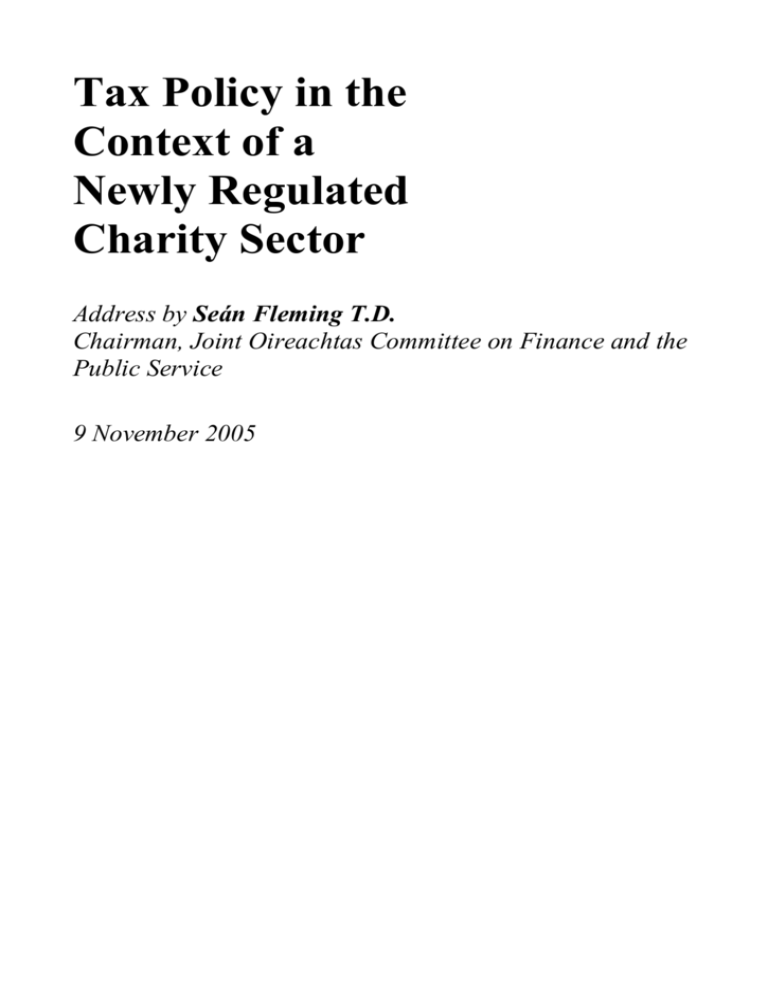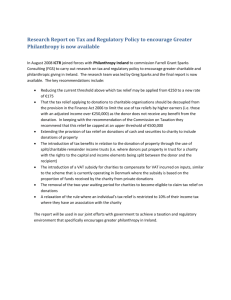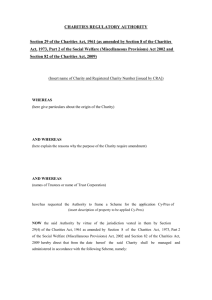A comprehensive reform of the law relating to charities will be
advertisement

Tax Policy in the Context of a Newly Regulated Charity Sector Address by Seán Fleming T.D. Chairman, Joint Oireachtas Committee on Finance and the Public Service 9 November 2005 Madam Chair, Guests If I could first of all offer my thanks to the Irish Charities Tax Reform Group for inviting me to deliver the opening address here today. I know that the Irish Charities Tax Reform Group has consistently and, at times, successfully made representations to the government in the years in recent years and I congratulate them on their resilience in pursuing their objectives. The 2002 Agreed Programme for government between Fianna Fáil and the Progressive Democrats pledged a comprehensive reform of the law relating to charities so as to ensure accountability and to protect against abuse of charitable status and fraud. In doing this though there should be no doubt as to the value which is placed on the work of charities, both in Ireland and abroad, by the Government and by the Irish people. New legislation will introduce an integrated system of mandatory registration, proportionate regulation and supervision. I emphasise the word proportionate. Clearly there are some very large charities and there are many smaller bodies and it is vital that we take account of this in the regulations. The independent regulatory body, to be positioned as the centrepiece of the regulatory regime, will be charged with setting up and maintaining a register of charities. Evidence suggests that the majority of charities in Ireland operate solely for the public good. However, it is vital for public trust and confidence in the sector to be safeguarded and maintained. Clearly, the lack of a regulatory regime leaves the sector vulnerable to abuses. The enormous response of the public to the tsunami disaster over last Christmas and New Year highlighted not only the great generosity of the Irish people, it also underlined the need for this regulation. Spring or early summer of 2006 has been publicly signalled as the target for publication of the Bill and the government continues to give priority to the work of advancing this important legislation. It is a major piece of legislation that will have over 200 sections. The proposed content of the new legislation has been the subject of an inclusive, public consultation process, first, in 2004, on the core legislative proposals and then, in 2005, on the specialist aspect of charitable trust law reform. There have been no major changes to charities legislation implemented in recent times. It has been over 40 years since the main legislation, the Charities Act 1961, was passed. The main trust law, which is also largely applicable to charitable trusts, dates back to the 19th century, to the Trustee Act 1893. In terms of tax policy, I have long believed that providing tax relief for donations to worthy causes stimulates individuals and companies to donate money to them. We have a tradition of voluntary effort and charitable donations. I also believe that if people want to donate money to good causes, then tax relief should be provided to encourage them to do so. We should also make it easy for people to do so. Certainly this was very much the rationale behind changes brought in over four years ago. Prior to the 2001 Finance Act, there were thirteen different reliefs for donations to various bodies with widely differing qualifying conditions. Having considered the area carefully, it was decided to simplify and rationalise the various tax reliefs in this area and, as part of this simplification process, most of the existing tax reliefs for donations were allowed to lapse. There was a major expansion in the relief, for example, for personal donations to domestic charities and educational establishments. In making this change the then Minister, Charlie McCreevy, was very conscious of the enormous contribution made by charitable donations in the United States, triggered by tax relief arrangements. This was a major change and was of immense benefit to charities. Before 2001 the corporate sector was defined as limited companies only. The new rules meant that sole traders and partnerships were included under the overhauled tax relief system. Companies were able to write off a donation as an ordinary trading expense, while the self-employed can claim the tax relief. This major change of grouping all reliefs with no restrictions as to which bodies donations could be made, be they charities, sports bodies, schools, universities, went far beyond what was realistically expected by the Irish Charities Tax Reform Group which never lobbied for such a change because it did not believe it would come into existence. There is no doubt that in the area of tax reform for charities, the government has gone above and beyond what was sought and have given what was never sought. Current Situation At present, to be granted charitable tax exemption by the Revenue Commissioners a body must be established solely for charitable purposes and the exemption applies only in so far as the funds are applied for charitable purposes only. The tax exemptions are from income tax, corporation tax, capital gains tax, deposit interest retention tax, capital acquisitions tax, stamp duty, probate tax and dividend withholding tax. Many of these exemptions are of very long standing and none have been altered or extended in the period since the government came to office in 1997. An eligible charity for the purposes of the scheme is any charity in the State which has been authorised by the Revenue Commissioners as an eligible charity and which holds charitable exempt status from the Revenue Commissioners for at least two years. Prior to the Finance Act 2005, this two-year waiting period had been three years. A further amendment to this tax relief was made in 2003 to restrict relief for donations by individuals to bodies of which they are members. In some cases, the individuals concerned were donating their entire salaries to such bodies and it was considered that the tax relief was not intended to cover such donations. The essence of charities is that there be no benefit to the donor. There has been publicity in recent times regarding donations to private schools upon which tax relief was claimed. It is important in all situations that the Revenue Commissioners are satisfied that there is no benefit either directly or indirectly to the donor. I am sure we are all agreed on the need vigilance This scheme for donations not only consolidated a series of reliefs for donations which had existed previously, such as tax relief for donations to third world charities and corporate donations to charities, but also, for the first time, extended the tax relief to donations by individuals to domestic charities. It was widely welcomed at the time by the charitable sector. There are no reliable estimates are available concerning the tax loss to the Exchequer of the principal exemptions from tax of charities as these bodies are not required to make tax returns. The amount of tax refunded by Revenue to Charities and other Approved Bodies in the case of individual PAYE donors since 2002 is almost €57 million As provided for in the relevant legislation, different tax relief arrangements apply in relation to donors paying tax under PAYE and those paying tax under the self assessment system. In the case of PAYE donors, the charity, approved body or sporting body recovers the tax associated with the donation on a grossed-up basis from Revenue. Donors who pay tax on a self-assessment basis claim the relief in their own tax returns. For the 2005 Finance Bill, the Irish Charities Tax Reform Group proposed a reduction in the minimum threshold for donations qualifying for tax relief from €250 to €100 and an extension of the current donations scheme to cover gifts of non-cash assets. In addition, the group has proposed the introduction of a VAT refund scheme for charities. Generally speaking, there is no upper limit on the amount which can be donated and qualify for relief. Donations must be in the form of money and can be on a cumulative basis for any one year. Thus, a weekly donation of €5 per week can qualify for the relief. The relief on the donation is at the individual’s marginal rate of tax. For example, if an individual who pays income tax at the higher rate of 42% gives a donation of €580 to an approved body, the body will be deemed to have received €1,000 less tax of €420. The approved body will, therefore, be able to claim a refund of €420 from the Revenue Commissioners at the end of the tax year. Similarly, if a standard rate taxpayer makes a donation of €800 to an approved body, the approved body will be able to claim a refund of €200 from the Revenue Commissioners at the end of the tax year. A reduction in the minimum qualifying donation would have the effect of increasing the numbers of donations qualifying for relief and would have cost implications for the Exchequer. Such a reduction would increase the administrative burden. Is there any evidence that the €250 limit has had any negative impact on the level of donations generally? Does it not provide the opportunity to boost charities further still? Has the full advantage really been gained from the relief. I mentioned earlier that almost €57 million has been refunded in taxes to charities since 2002. However what is interesting to me is that the total fell from €21.4 million in 2003 to €14.8 million in 2004. Perhaps people here today could shed some light on the fall in 2004. To the end of September this year, €9.2 million has been refunded by the Revenue Commissioners. It is expected that claims for refunds on donations made to charities in the wake of the Tsunami disaster will not appear in claims lodged with Revenue next January and that refunds made to charities and other approved bodies in 2005 would mostly be exclusive of these donations. Regarding the donation of non-cash items, the position is that where an asset is donated to an eligible charity, the donation for capital gains tax, CGT, purposes is deemed to be such that neither a gain nor loss accrues to the donor on the disposal. Therefore, no tax charge arises in respect of such a donation and any gain on a subsequent disposal of the asset by the charity is not a chargeable gain provided it is applied for charitable purposes only. Income tax relief on the value of an asset donated as proposed by the Irish Charities Tax Reform Group, together with the current CGT exemption, would amount to a double relief. Such a concession could result in tax relief being granted which was well beyond the top rate of income tax. In addition, the means whereby the relief is currently given in the case of a PAYE donor presupposes that the individual is making the donation from income on which he or she has paid income tax to the value of the relief being claimed. While there is some prospect that this is so when the donation is in the form of money, such a link may be broken where noncash items are involved. Perhaps, the Irish Charities Tax Reform Group could refine this proposal to eliminate the possibility of double tax relief and perhaps consider a proposal whereby one relief which is most beneficial could be claimed only. Some taxpayers are chargeable persons for the purposes of self-assessment but also pay tax under the PAYE system. These taxpayers must claim the tax relief on their donation through their tax return in common with all self-assessed taxpayers. They cannot be included in claims being made by charities in respect of wholly PAYE taxpayers. To do so would be to grant the relief twice. I understand that this particular aspect of the scheme has resulted in some difficulties for charities in compiling claims for repayment. Frequently, such claims include donors who have had a mix of PAYE and selfassessed income for the year, a fact not known to the claiming bodies and as a result incorrect claims have had to be reduced in a number of cases. The donations scheme is being examined as part of the overall review of tax reliefs currently being undertaken by the Department of Finance and the Revenue Commissioners. These reviews will be considered in the context of the budget. The Minister for Finance tells me that it is normal practice at this time of year to refrain from giving any indication as to what measures may or may not be contained in the budget. With regard to the issue of VAT, the position is governed by EU VAT law with which Irish VAT law must comply. Under the EU sixth VAT directive, where charities and non-profit organisations are engaged in noncommercial activities, they are exempt from charging VAT on the services they provide but cannot recover VAT on goods and services which they purchase. Essentially, only VAT registered businesses are able to recover VAT. I know that a report commissioned by the Irish Charities Tax Reform Group in 2003 indicated that charities incur a VAT bill of €18 million on their inputs. This led to calls for a refund which were rejected on the grounds of expense, especially as there would be pressure to extend such a scheme to charities not represented by the Irish Charities Tax Reform Group and to other non-profit organisations. Indeed, such a system could encourage registration as charities by other organisations to benefit from such funding. I believe this is something we do have to keep in mind. To conclude, I want to compliment the Irish Charities Tax Reform Group for their pioneering work over the years. They have made a huge contribution to promoting charitable donations. I am pleased that recent governments have responded generously to the proposals. This is precisely what the Irish people would wish and I look forward to further improvements in this area in future years.




